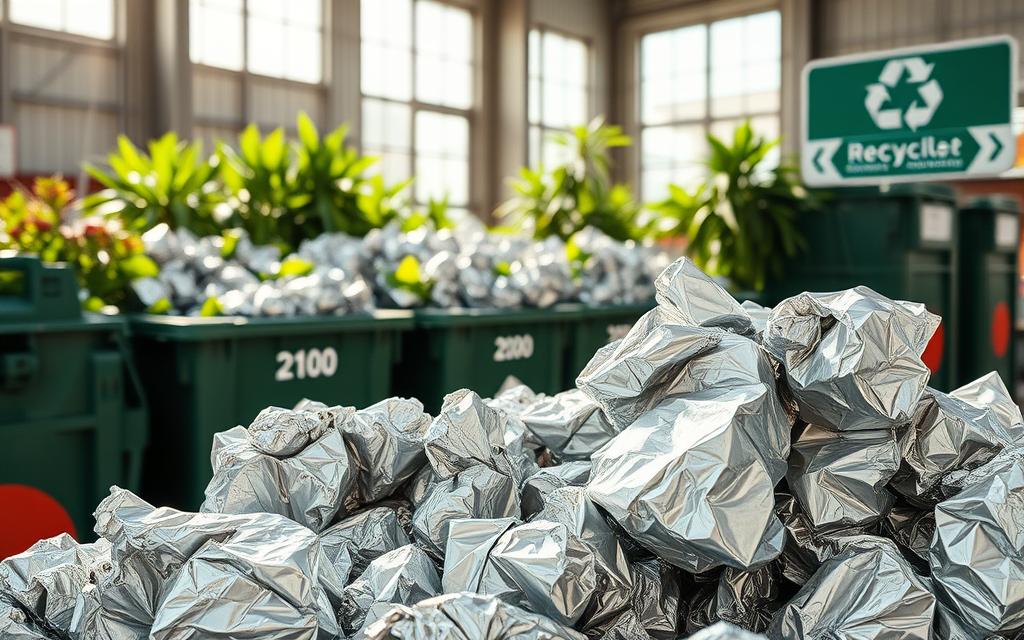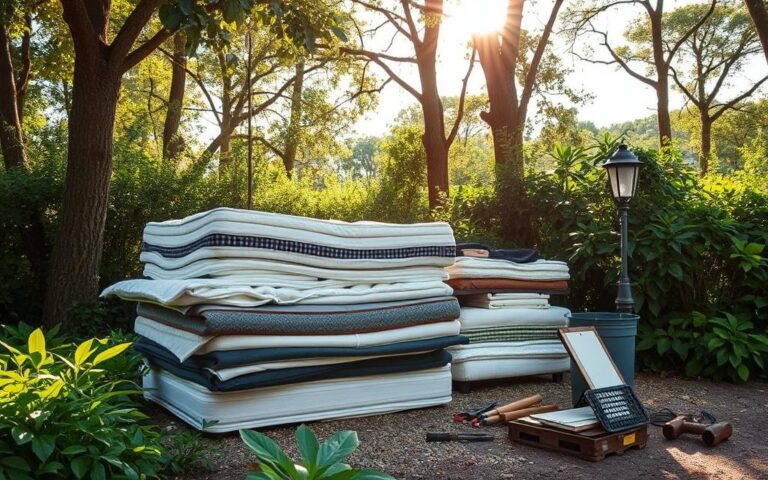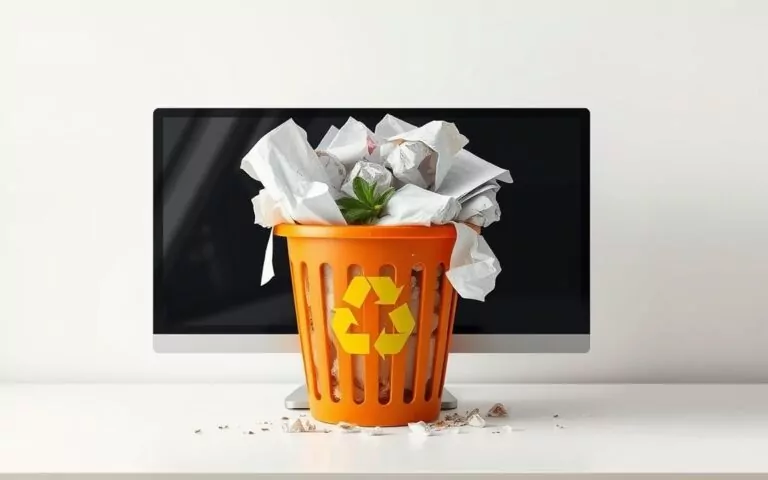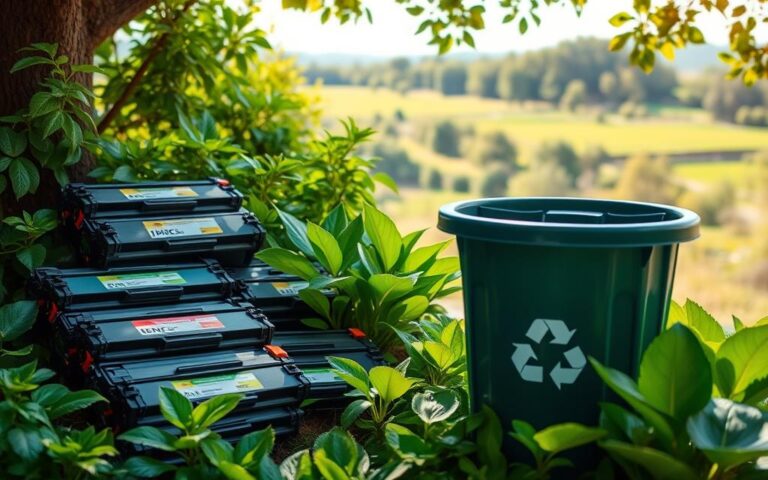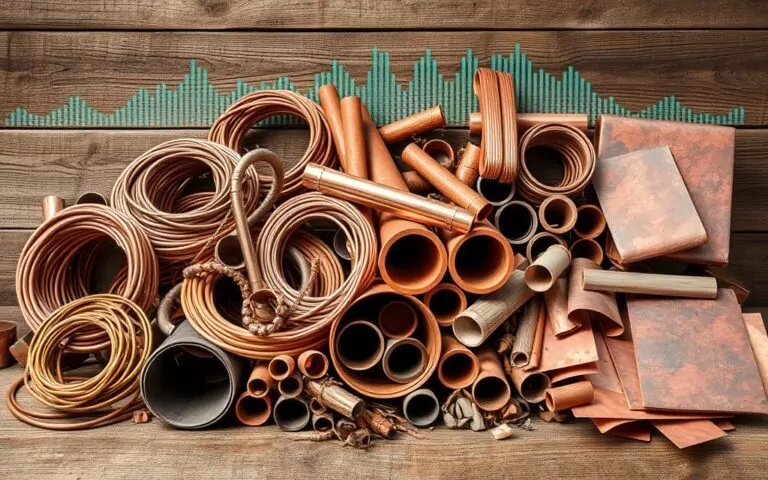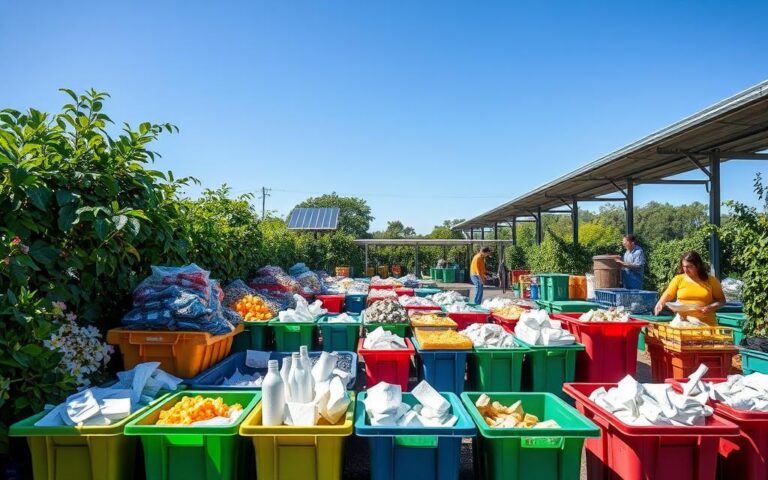Can Tin Foil Be Recycled? Key Guidelines for Disposal
Today, many people and businesses are focusing on being eco-friendly. It’s crucial to know how to dispose of things like tin foil properly. As we aim for a greener earth, figuring out if tin foil can be recycled helps us handle waste better. This piece sheds light on recycling tin foil, showing how we can all help lessen landfill trash and care for our planet.
Understanding Tin Foil and Its Composition
Tin foil is mainly made of aluminium. It has properties of aluminium foil that are really useful at home and in cooking. It’s strong but flexible, so you can use it for lots of things.
Aluminium foil is great at keeping food fresh. It stops light, moisture, and air from getting in. It’s also safe for food because it’s non-toxic. Knowing about the different types of foil, like heavy-duty or standard, helps you pick what you need.
Recycling aluminium foil is good for our planet. You can recycle it over and over, and it won’t lose its quality. To learn more about recycling foil, check out this link.
| Property | Description |
|---|---|
| Malleability | Can be shaped easily without breaking. |
| Barrier Properties | Protects food from light, moisture, and air. |
| Durability | Strong enough for various cooking methods, including grilling and baking. |
| Non-Toxic | Safe for food storage and cooking applications. |
Common Uses of Tin Foil
Aluminium foil is very useful in our daily lives. It helps keep food like meats, veggies, and dairy fresh. Since it reflects light and heat, it stops perishable items from going bad.
In the kitchen, foil is a top choice for baking. It stops food from sticking, so treats like cookies and cakes come out easily. It’s also great for grilling and roasting, as it keeps the heat in and cooks food just right.
Outside of cooking, foil is key in packaging. It wraps products to keep them fresh longer. For example, it keeps medicine safe from moisture and light.
Foil’s benefits don’t end there. It also helps insulate homes from noise and heat. This makes it super useful, not just in the kitchen but in buildings too. It’s something a lot of us use without even thinking about how versatile it is.
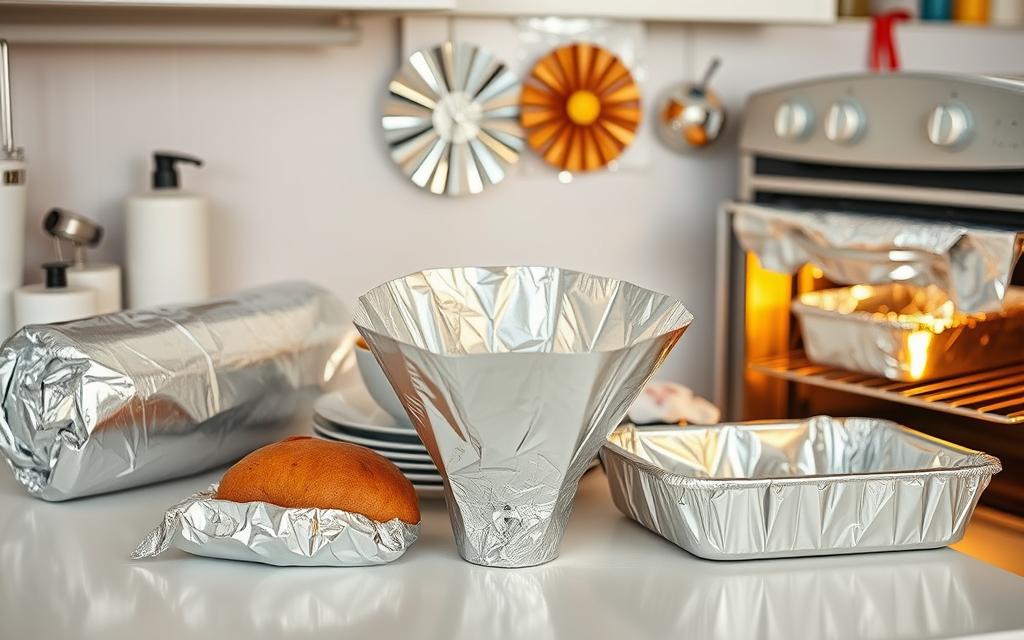
| Application Area | Specific Uses |
|---|---|
| Food Preservation | Wrapping meats, vegetables, and cheeses |
| Cooking | Lining trays, covering dishes, and steaming |
| Packing | Pharmaceutical packaging, snack and meal preparation |
| Construction | Thermal insulation and soundproofing |
Can Tin Foil Be Recycled?
Recycling aluminium foil comes with its ups and downs. It can be recycled over and over without losing its goodness. But, its small size and the need to be clean make recycling tricky.
Recyclability of Aluminium Foil
In the US, about 60% of aluminium gets recycled. It uses 90% less electricity than making new aluminium. Some places recycle up to 90% of their aluminium items. Others only manage about 35%. Up to 75% of all aluminium ever made is still in use today. This shows how well aluminium can be recycled. Yet, not all recycling centres will take aluminium foil because it can get dirty and cause problems.
Contamination Issues
Foil often gets dirty with food, which makes recycling hard. It has to be clean to be recycled right. If foil is too dirty or has stuff stuck to it, it might not be recyclable. Some cities like Houston and El Paso ask people to recycle clean aluminium trays and foil. But, what you can recycle changes depending on where you live. Knowing your local rules helps make the most of recycling aluminium foil.
Steps for Proper Disposal of Tin Foil
To dispose of tin foil properly, there are key steps. They help with cleaning and getting ready for recycling. These actions make our environment better. By following them, we make sure the foil is clean and ready for recycling, making the process smoother and lessening contamination.
Cleaning Methods
Start by rinsing off any food bits and grease from the aluminium foil. This step is critical because dirt can stop the recycling process. After rinsing, it’s crucial to dry the foil completely. Wet foil might not be recyclable. Then, flatten the clean foil to aid in sorting it for recycling.
How to Prepare for Recycling
For successful recycling, gather and squish clean pieces of aluminium foil into a big ball. This simplifies the recycling centre’s job. It’s also important to check your area’s recycling rules as they can differ a lot. Knowing these rules helps you recycle right and follow the regulations.
| Steps for Proper Disposal | Description |
|---|---|
| 1. Rinse the Foil | Remove any food residue and grease to prevent contamination. |
| 2. Dry Completely | Ensure no moisture remains on the foil. |
| 3. Flatten | Flatten the foil to facilitate sorting and processing. |
| 4. Compress | Gather and compress clean foil pieces into a ball. |
| 5. Check Recycling Guidelines | Consult local regulations to ensure compliance. |
Tackling Common Misconceptions About Tin Foil Recycling
Many people have myths about foil recycling that stop good recycling habits. One big myth is thinking all foil types are recyclable easily. However, whether aluminium foil can be recycled often depends on if it’s clean and the rules of local recycling schemes. This misunderstanding leads to wrong ways of throwing things away.
Size of the foil matters too, contrary to what some think. Tiny pieces of foil usually miss the recycling process because they slip through sorting machines. Knowing more about awareness on recycling can help us do better and recycle more materials properly.
To fight these understanding misconceptions, teaching the public how to recycle right is key. Below is a table with facts about recycling tin foil:
| Myth | Fact |
|---|---|
| All foil is recyclable. | Only clean and dry foil is accepted for recycling. |
| Size does not matter. | Smaller pieces may not be recycled effectively. |
| All recycling is easy. | Many recycling systems vary in guidelines, affecting convenience. |
| Foil can’t be recycled with other metals. | Some programmes allow mixed metal recycling if sorted correctly. |
By continuing to educate, communities can get better at recycling and reduce trash in landfills. Dealing with these myths about foil recycling helps everyone make smarter choices. It improves our environmental impact. Encouraging people to find out about their local recycling options can change how we all recycle.
Benefits of Recycling Tin Foil
Recycling aluminium foil brings many benefits for both people and the planet. It helps us work together to improve our environment. Knowing the advantages encourages more of us to take part, leading to big positive changes.
Environmental Impact
Recycling aluminium foil is key in cutting down waste. It can be reused for new products instead of ending up in landfills. This helps save our natural resources.
Moreover, it greatly lowers greenhouse gas emissions compared to making new aluminium. By recycling, we’re taking care of our planet in a responsible way.
Energy Savings
The amount of energy saved by recycling aluminium is impressive. It takes 95% less energy than making it from raw bauxite.
Recycling just one pound, or about 33 cans, saves roughly 7 kWh of electricity. This is enough to keep a 100-watt bulb lit for four hours. It’s a compelling reason to support recycling efforts.
Such energy savings mean lower electric bills and help fight climate change.
| Recycling Method | Energy Saved (kWh) | Environmental Impact |
|---|---|---|
| Recycling 1 Aluminium Can | 0.24 | Reduces landfill waste by extending material life |
| Recycling 40 Aluminium Cans | 9.6 | Equivalent to fuel savings of one gallon of gasoline |
| Recycling 1 kg of Aluminium | 14 | Saves 4 kg of chemical products and 6 kg of bauxite |
Conclusion
Tin foil recycling is key for keeping our planet healthy. Aluminium foil is 100% recyclable and can be reused many times. But, it’s important to throw it away right to avoid problems. Every year, the UK throws away 20,000 tonnes of foil. So, following the right steps is crucial.
People have a big part to play in recycling foil. By cleaning foil before binning it, we make sure it gets recycled properly. This saves lots of energy, up to 95% less than making new aluminium. It also cuts down on harmful gases and saves our resources.
Recycling foil is good for the Earth and brings people together to care for our home. Talking about recycling can push more of us to do our part. Every little action helps. By doing the right thing and encouraging others, we help our planet. Let’s all work for a greener future together.
FAQ
Can tin foil be recycled?
Yes, you can recycle tin foil, which is mostly made of aluminium. It must be clean and free from any food or waste to be recycled right.
What are the proper steps to prepare aluminium foil for recycling?
First, rinse any food or grease off the aluminium foil. Make sure it’s dry. Then, flatten or roll it into a ball. This makes sorting easier.
Are all types of tin foil recyclable?
Not every foil can be recycled. Foil with food left on it, or mixed with other materials, often can’t be. It’s best to check what your local area says about recycling.
What common misconceptions exist about recycling tin foil?
Some people think all foil can be recycled easily. Another mistake is thinking the size of foil doesn’t matter. But, small pieces are hard to sort and can cause problems.
What are the environmental benefits of recycling aluminium foil?
Recycling foil lessens the need to get new materials, cuts down waste in landfills, and reduces pollution. Also, it uses up to 95% less energy than making new aluminium from ore.
How does recycling aluminium foil contribute to sustainability?
By recycling foil, we use fewer new resources. This lowers harmful carbon emissions. It supports our goals to take care of our planet better.

